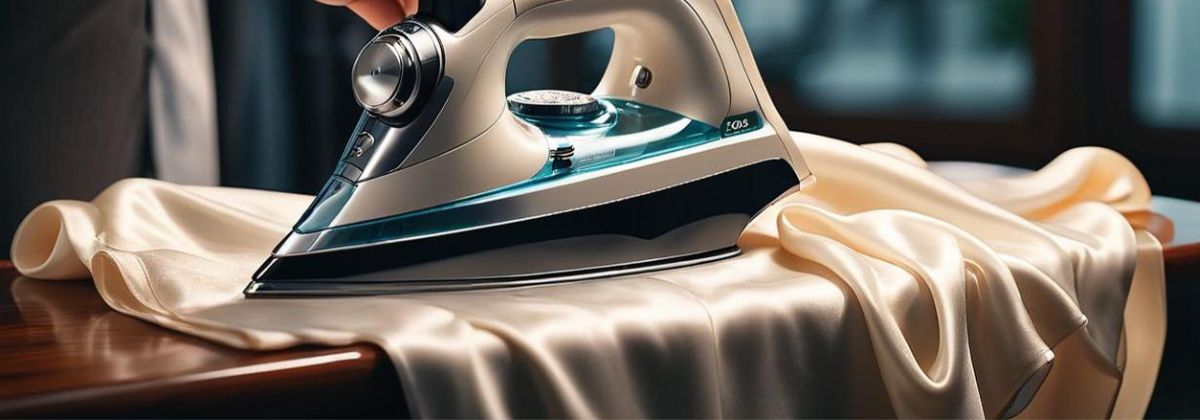17 Jun Effective Techniques for Ironing Silk Fabrics: A Comprehensive Guide
Silk clothes are a luxurious addition to any wardrobe but require special care to maintain their elegance and durability. Ironing silk fabrics can be daunting due to the fabric’s delicate nature, but with the right techniques and equipment, it can be done safely and effectively.
Tips For Ironing Silk Fabrics
Silk Fabric
Silk is a natural protein fibre known for its soft, smooth texture and shimmering appearance. It’s commonly used in high-end clothing such as blouses, dresses, and scarves. Silk’s delicate nature makes it prone to wrinkles and damage if improperly handled.
1. Types of Silk Fabrics
- Charmeuse: Known for its smooth surface and glossy finish, charmeuse silk is often used in lingerie and evening gowns.
- Chiffon: A lightweight, sheer fabric with a slightly rough texture, chiffon silk is famous for scarves and evening wear.
- Satin: Characterised by its smooth, shiny surface on one side, satin silk is favoured for bridal gowns and formal attire.
2. Properties of Silk
- Smoothness: Silk fibres are incredibly smooth, contributing to the fabric’s luxurious feel and drape.
- Lightweight: Despite its durability, silk is lightweight and comfortable in various climates.
- Breathability: Silk has natural temperature-regulating properties, keeping you cool in summer and warm in winter.
- Absorbency: Silk can absorb moisture without feeling damp, making it comfortable for all-day wear.
Preparing for Ironing Silk Clothes
Before ironing silk clothes, taking a few preparatory steps is crucial to ensure the best results and protect the delicate fabric.
- Checking the Care Label: Always check the care label on your silk garment for specific ironing instructions. Silk is a delicate fabric, and the manufacturer’s recommendations will guide you on the appropriate heat settings and any special precautions.
- Testing for Heat Sensitivity: To prevent damage, perform a heat sensitivity test on a small, inconspicuous area of the garment. Use the lowest heat setting on your iron and place a pressing cloth over the fabric. Proceed cautiously if there are no adverse effects like colour changes or shrinkage.
- Proper Cleaning Before Ironing: Ensure your silk garment is clean before ironing. Follow the care instructions for washing or dry cleaning to remove any dirt or stains. Ironing a dirty garment can set stains and damage the fabric.
Choosing the Right Ironing Equipment
Selecting the appropriate ironing equipment is crucial when dealing with delicate silk fabrics. Here’s what you need to consider to ensure the best results:
- Types of Irons Suitable for Silk: Not all irons are suitable for silk due to their delicate nature. Look for irons with adjustable temperature settings designed explicitly for silk or delicate fabrics. These irons allow you to control the heat to prevent damage to the silk fibres.
- Adjusting Temperature Settings: Set your iron to a low temperature appropriate for silk fabrics before ironing it. Some irons have specific settings labelled for silk, which typically range from 110°C to 150°C (230°F to 302°F). Always start with a lower temperature and increase cautiously if needed, ensuring the iron is not too hot for the fabric.
Dealing with Wrinkles and Stubborn Creases
Silk garments are prone to wrinkles, but with the proper techniques, you can effectively remove them without damaging the delicate fabric. Here’s how to deal with wrinkles and stubborn creases:
- Ironing Inside Out: Turn your silk garment inside out before ironing. This method helps protect the fabric’s outer surface from direct heat, reducing the risk of shine marks or damage.
- Avoiding Steam Directly on Silk: Silk can be sensitive to Steam, which may cause water spots or stains. Instead of using Steam directly on the fabric, use a pressing cloth between the iron and the silk garment. This method lets you gently press out wrinkles without exposing the silk to excess moisture.
- Handling Seams and Delicate Areas: Pay special attention to seams, buttons, and delicate embellishments when ironing silk. Glide the iron carefully over these areas to avoid stretching or damaging the fabric.
Special Tips for Delicate Silk Fabrics
Silk is a luxurious and delicate fabric that requires extra care to maintain its beauty and longevity. Here are some special tips to keep your silk garments looking their best:
- Using a Pressing Cloth: Always use a pressing cloth when ironing Silk. Place a clean, white cloth or a piece of muslin between the iron and the silk garment. This layer protects the fabric from direct heat and prevents shine marks.
- Ironing at the Right Time: Iron your silk garments when they are slightly damp. If the fabric is too dry, it can be more prone to heat damage. Lightly mist the garment with water using a spray bottle or use the iron’s mist setting before ironing.
- Avoiding Direct Sunlight: When drying or ironing Silk, avoid direct sunlight. UV rays can weaken the silk fibres and cause the colour to fade. Dry silk garments are shaded, and iron is in a well-lit but not sunny space.
- Storing Silk Properly: Remember to store silk garments in a cool, dry place. Use padded hangers to maintain the shape of the garments and avoid wire hangers, which can leave marks or stretch the fabric. If you need to fold silk items, place tissue paper between the folds to prevent creasing.
- Using Gentle Cleaning Products: When washing Silk, use a gentle detergent specifically designed for delicate fabrics. Harsh chemicals can damage Silk, so always opt for a mild, silk-safe detergent and soak it in cool water.
- Dry Cleaning Recommendations: Consider professional dry cleaning for heavily soiled or intricately designed silk garments. Inform the cleaner that the garment is made of Silk so they can use the appropriate cleaning methods.
Preventing Damage to Silk While Ironing
Silk is an exquisite yet fragile fabric, requiring meticulous care during ironing to prevent damage. Here are key strategies to safeguard your silk garments while achieving a smooth, wrinkle-free finish:
- Use a Low-Temperature Setting: Always set your iron to the lowest temperature suitable for silk, typically between 110°C and 150°C. Higher temperatures can scorch or burn the delicate fibres, so it’s essential to start low and adjust if necessary.
- Employ a Pressing Cloth: Place a pressing cloth, such as a clean white cotton cloth or muslin, between the iron and the silk garment. This barrier protects the silk from direct heat, preventing shine marks and potential scorching.
- Iron on the Reverse Side: Ironing silk on the reverse side helps protect the fabric’s sheen and surface. Turn your garment inside before ironing to minimise direct heat exposure on the visible side.
- Avoid Using Steam Directly: Direct steam can cause water spots and stains on silk. Instead, lightly mist the garment with water using a spray bottle or use the iron’s mist setting through the pressing cloth. This method ensures even moisture distribution without soaking the fabric.
- Test a Small Area First: Before ironing the entire garment, test a small, inconspicuous area to ensure the fabric reacts well to the heat. This step helps you avoid widespread damage if the silk is particularly sensitive.
- Handle with Care: Be gentle when moving the iron over the silk. Avoid pressing too hard, especially on delicate seams, hems, and embellishments. A light touch prevents stretching and distortion of the fabric.
- Keep the Iron Moving: Avoid leaving the iron in one spot too long. Continuously move the iron in smooth, even strokes to prevent heat buildup in any one area, which can lead to scorching.
Alternative Methods to Ironing Silk
Ironing silk fabrics isn’t the only way to remove wrinkles from silk garments. Here are some alternative methods that can help you keep your silk looking smooth and pristine without the risk of direct heat damage.
- Using a Steamer: A garment steamer is an excellent alternative to ironing silk. Steamers are gentler and less likely to cause heat damage. Hang your silk garment and gently run the steamer up and down, keeping a small distance between the steamer and the fabric to prevent water spots.
- The Shower Method: Hang your silk garment in the bathroom while you shower. The steam from the shower will help relax the fibres and release wrinkles. Ensure the garment is not in direct contact with water to avoid water spots.
- Wrinkle Release Sprays: Commercial wrinkle release sprays can quickly fix minor wrinkles. Lightly spray the garment and gently smooth out the fabric with your hands. Be sure to use a safe spray for delicate fabrics like silk.
- Rolling Technique: For smaller items like scarves, try the rolling technique. Lay the silk flat on a clean, smooth surface, then roll it up tightly with tissue paper. Leave it rolled for a few hours to help smooth out the wrinkles.
- Drying with Care: When washing silk, how you dry it can affect wrinkles. Instead of wringing out silk, gently press the water out with a towel. Hang the garment to dry, preferably flat on a clean towel. This method reduces the formation of wrinkles.
- Professional Cleaning: Professional dry cleaning is often the safest option for heavily wrinkled or delicate silk garments. Dry cleaners have specialised equipment and expertise to handle silk with the utmost care.
The Last Word
Ironing silk clothes requires a gentle touch and careful attention to detail. By following these guidelines, you can keep your silk garments looking beautiful and extend their lifespan. Practice makes perfect, so don’t be afraid to take your time and treat your silk with the care it deserves.




Sorry, the comment form is closed at this time.